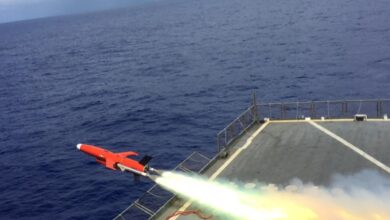Ukraine drones show sanctions don’t clip Russia’s wings
Russia’s ability to field a large force of unmanned aerial vehicles means the operators of Ukraine’s air defense systems don’t look forward to sunny days with little wind.
Ukrainian forces must contend with two to three drone sorties a day by Russian or Russian-allied militants in the Donbass. On some occasions as many as 10 UAVs are launched in a single day if weather conditions are optimal.
In 2018, Russia deployed 741 UAVs across the 409-km front line between Ukraine and the Russian occupied east of the country.
Those figures were provided by Major General Borys Kremenetskyi, the Defense and Air attaché to the Ukranian embassy in London during a briefing at SMi-organized UAV Technology conference this week.
Despite international sanctions, Russia is able to continue to launch such a large number of drones thanks to a steady supply of spare parts acquired abroad.
Many of the technologies used by Russia’s UAV force are commercially available in several countries. In particular, Russian drones use foreign parts in the engines, high-definition cameras, and propellers, and Russian forces have deployed dozens of types of unmanned aerial systems with small variations.
One Russian Takhion UAV downed in Ukraine included a veritable “United Nations” of components: The video recorder and camera were from Japan, a video decoder came from Sweden, and an engine counter-worker was German-made. The battery, air-speed and barometric altitude instrumentation all came from China. A Forpost 923 UAV shot down in 2015 included parts made in Israel.
“Rarely do we see Russian made parts in the engines in drones, so while this may say something about Russian technological capabilities we, we should not underestimate them,” said Kremenetskyi, who provided photos of the alleged equipment to support his claim.
While most of Russia’s drones in the skies over Ukraine are providing reconnaissance, others have done damage to critical infrastructure or have been used in psychological operations, such as sending text messages to individual Ukrainian soldiers aimed at demoralizing them.
“The Russian war in Ukraine should be a wake-up call that drones are being used this way in war. This is happening in Europe,” said Paul Taylor of Enterprise Control Systems, the British manufacturer of electronic systems used to detect, track and defeat drones, who attended the SMi event.
Though Kremenetskyi did not touch on the issue, Russia’s drones in Syria also rely on foreign parts. In Syria, however, Russia has a foreign drone problem of its own.
During a press statement last month Russian Defense Ministry spokesperson Major General Igor Konashenkov seemed to lament the improvised drones fielded against Russia in Syria, which Moscow alleges were operated with advanced international components.
“It’s quite worrying that the terrorists have obtained the navigation and control technologies that only a few countries possess,” he said.












